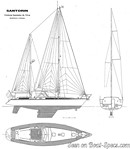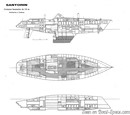Santorin
Sailboat specifications
The Santorin is a 45’4” (13.8m) cruising sailboat designed by Jacques Carteau (France). She was built between 1989 and 1997 by Amel (France).
Santorin's main features
- Model
- Santorin
- Hull type
- Monohull
- Category
- Offshore cruising sailboat
- Sailboat builder
- Sailboat designer
- Country
- France
- Construction
- GRP (glass reinforced polyester):
- Hull: Single skin fiberglass polyester
- Deck: Sandwich fiberglass polyester - Number of hulls built
- About 150
- First built hull
- 1989
- Last built hull
- 1997
- Appendages
- Keel : fin with bulb
- Helm
- Single helm wheel
- Rudder
- Single rudder on skeg
- Unsinkable
- No
- Trailerable
- No
- Former French navigation category
- 1
- Standard public price ex. VAT (indicative only)
- About264 000 €(1993)
Santorin's main dimensions
- Overall length
- 45’ 11”14 m
- Hull length
- 45’ 4”13.8 m
- Waterline length
- 35’ 1”10.7 m
- Beam (width)
- 13’ 1”4 m
- Waterline beam (width)
- 11’ 2”3.4 m
- Draft
- 6’ 2”1.9 m
- Mast height from DWL
- 55’ 10”17 m
- Light displacement (MLC)
- 18739 lb8500 kg
- Maximum displacement (MLDC)
- 24251 lb11000 kg
- Ballast weight
- 8157 lb3700 kg
Santorin's rig and sails
- Upwind sail area
- 969 ft²90 m²
- Downwind sail area
- 1238 ft²115 m²
- Mainsail area
- 248 ft²23 m²
- Mizzen sail area
- 140 ft²13 m²
- Mizzen staysail area
- 237 ft²22 m²
- Genoa area
- 581 ft²54 m²
- Symmetric spinnaker area
- 614 ft²57 m²
- Rigging type
- Ketch Marconi (in-mast furling mainsail) masthead
- Mast configuration
- Deck stepped mast
- Rotating spars
- No
- Number of levels of spreaders
- 2
- Spreaders angle
- 0 °
- Spars construction
- Aluminum spars
- Standing rigging
- 1x19 strand wire
Santorin's performances
- Upwind sail area to displacementiThe ratio sail area to displacement is obtained by dividing the sail area by the boat's displaced volume to the power two-thirds.
The ratio sail area to displacement can be used to compare the relative sail plan of different sailboats no matter what their size.
Upwind: under 18 the ratio indicates a cruise oriented sailboat with limited performances especially in light wind, while over 25 it indicates a fast sailboat. - 233 ft²/T21.61 m²/T
- Downwind sail area to displacementiThe ratio sail area to displacement is obtained by dividing the sail area by the boat's displaced volume to the power two-thirds.
The ratio sail area to displacement can be used to compare the relative sail plan of different sailboats no matter what their size. - 240 ft²/T22.33 m²/T
- Displacement-length ratio (DLR)iThe Displacement Length Ratio (DLR) is a figure that points out the boat's weight compared to its waterline length. The DLR is obtained by dividing the boat's displacement in tons by the cube of one one-hundredth of the waterline length (in feet).
The DLR can be used to compare the relative mass of different sailboats no matter what their length:
a DLR less than 180 is indicative of a really light sailboat (race boat made for planning), while a DLR greater than 300 is indicative of a heavy cruising sailboat. - 196
- Ballast ratioiThe Ballast ratio is an indicator of stability; it is obtained by dividing the boat's displacement by the mass of the ballast. Since the stability depends also of the hull shapes and the position of the center of gravity, only the boats with similar ballast arrangements and hull shapes should be compared.
The higher the ballast ratio is, the greater is the stability. - 44 %
- Critical hull speediAs a ship moves in the water, it creates standing waves that oppose its movement. This effect increases dramatically the resistance when the boat reaches a speed-length ratio (speed-length ratio is the ratio between the speed in knots and the square root of the waterline length in feet) of about 1.2 (corresponding to a Froude Number of 0.35) . This very sharp rise in resistance, between speed-length ratio of 1.2 to 1.5, is insurmountable for heavy sailboats and so becomes an apparent barrier. This leads to the concept of "hull speed".
The hull speed is obtained by multiplying the square root of the waterline length (in feet) by 1.34. - 7.94 knots
Santorin's auxiliary engine
- Engine(s)
- 1 inboard engine
- Engine(s) power
- 50 HP
- Fuel type
- Diesel
- Fuel tank capacity
- 105.7 gal400 liters
Santorin's accommodations and layout
- Cockpit
- Center cockpit
- Cabin(s)
- 2
- Berth(s) (min./max.)
- 5 / 7
- Freshwater tank capacity
- 211.3 gal800 liters





Amel Santorin interior and accommodations - - 4/6
Picture extracted from the commercial documentation © Amel
Picture extracted from the commercial documentation © Amel


Amel Santorin interior and accommodations - - 5/6
Picture extracted from the commercial documentation © Amel
Picture extracted from the commercial documentation © Amel


Amel Santorin interior and accommodations - - 6/6
Picture extracted from the commercial documentation © Amel
Picture extracted from the commercial documentation © Amel
Similar sailboats that may interest you:
Sailboats
First built hull
Hull length
2002
40’ 8”12.4 m
1993
44’13.4 m
2007
44’ 6”13.57 m
1978
45’ 4”13.8 m
1988
52’ 6”16 m
2003
44’ 4”13.49 m
2016
44’ 11”13.68 m
2016
44’ 4”13.5 m
1987
48’ 1”14.65 m
2000
52’ 6”16 m
2017
50’ 11”15.51 m
2013
42’ 2”12.85 m
2005
44’ 11”13.7 m
2018
45’ 11”13.99 m
1992
48’ 10”14.88 m